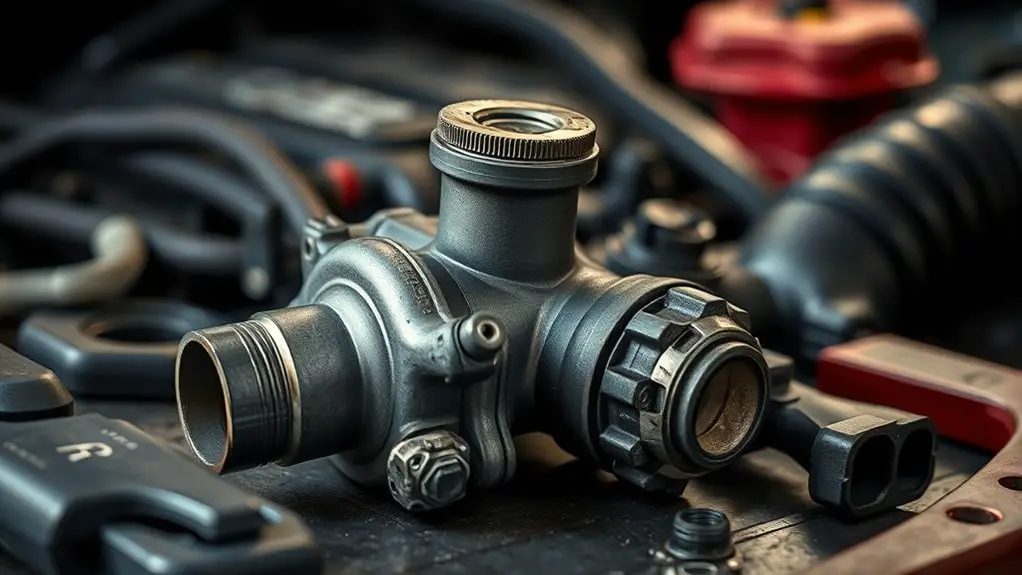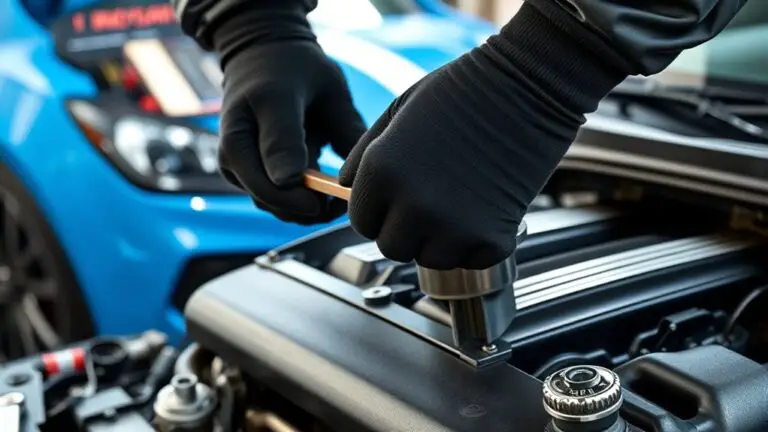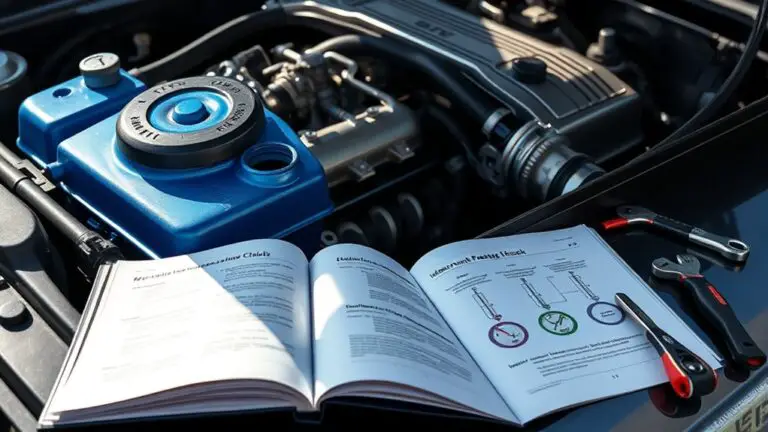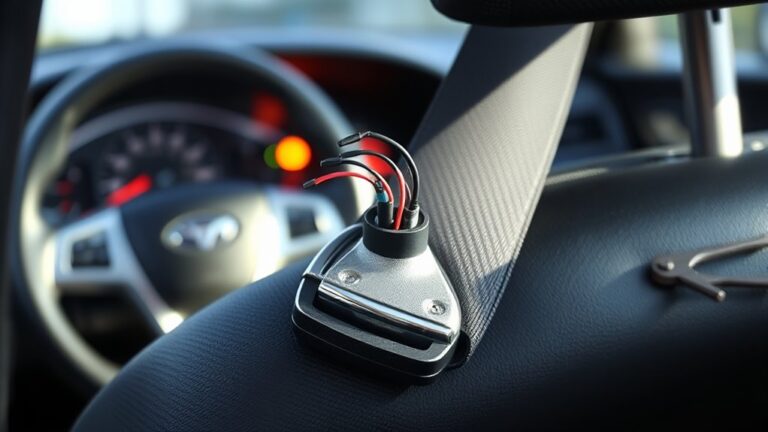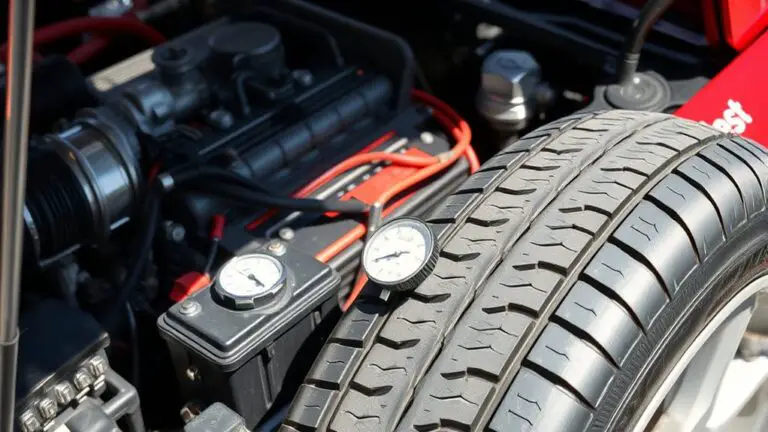When to Repair Vs Replace a EGR Valve That Affects Emissions
If your EGR valve affects emissions, you should repair it when tests show intermittent function and emissions remain within limits, and cleaning clears carbon buildup enough to restore proper flow. Replace it when faults persist after cleaning and diagnostics show unreliable actuation or failed flow, risking emissions compliance. Weigh repair cost, downtime, and warranty against full replacement, which offers predictability. Durable fixes and preventive maintenance will reduce future issues, and continuing guidance helps you plan the next steps.
Symptoms That Point to an EGR Valve Issue
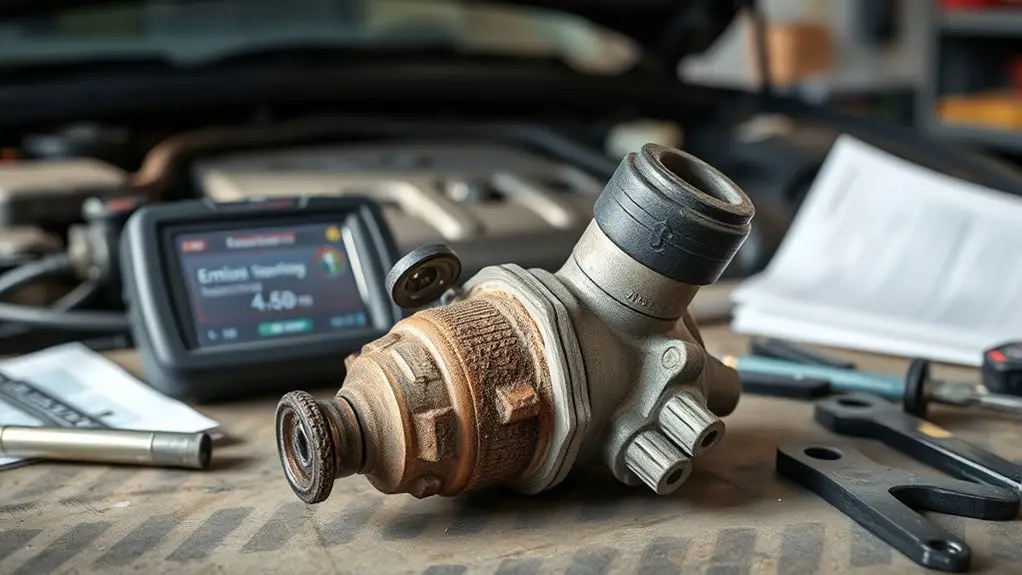
Common symptoms of an EGR valve problem include rough idle, stalling, and reduced engine performance, especially at light throttle. You’ll notice irregular idle, higher exhaust temperatures, and occasional misfires as the valve sticks or floats. EGR valve symptoms also include a loss of low-end torque and a dip in fuel efficiency, since the recirculated exhaust disrupts proper air-fuel mixing. You may experience a check engine light or an emissions warning if the PCM detects abnormal backpressure or incorrect intake flow. When the valve clogs, you’ll feel hesitation during acceleration and a jerky response at light loads. Conversely, excessive EGR flow can cause rough running at idle or stall outright. Diagnosing these symptoms requires measuring vacuum signals, inspecting the valve for carbon buildup, and verifying that the EGR passages are clear. Address symptoms promptly to avoid leaning toward a larger emissions warning or catalytic inefficiency.
When Repairing Makes Sense: Common Scenarios
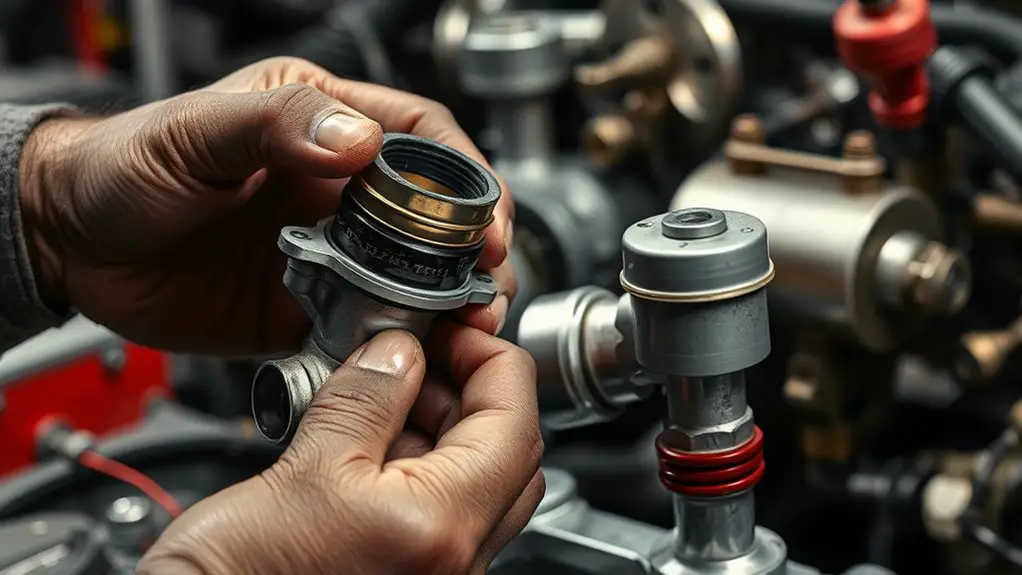
When you’re weighing repair versus replacement, certain scenarios strongly favor fixing the EGR valve rather than tossing it out. First, if the valve exhibits intermittent malfunctions but tests within spec, targeted EGR valve maintenance can restore functions without a full swap. Second, when deposits and clogging are localized to the valve passages, cleaning and lubricating channels often yield reliable performance at a lower cost than replacement. Third, if fault codes point to valve actuation issues but the wiring and controls are solid, repairable components or reseating the valve can resolve symptoms with minimal downtime. Fourth, early-stage sticking or fluttering, caused by carbon buildup, responds well to short maintenance cycles and high-quality cleaners. In these cases, consider cost effective solutions that preserve emissions compliance while extending service life. Avoid aggressive repairs that mask root causes; prioritize diagnostics and documentable improvements through EGR valve maintenance.
When Replacement Is the Safer Choice
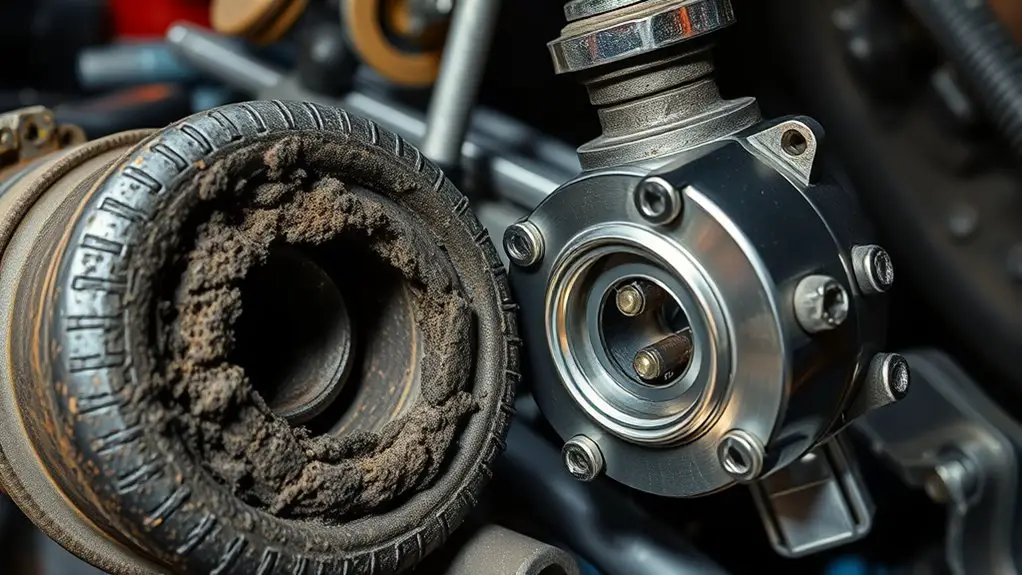
Replacing the EGR valve becomes the safer choice when diagnostic tests clearly show persistent faults that impair emissions control or engine performance beyond the repairable threshold. You’ll opt for replacement when EGR valve malfunction signs persist after calibrated cleaning, flow tests, and actuator checks, and you still observe abnormal backpressure, irregular idle, or reduced torque under load. In that scenario, staying within emissions regulation demands a decisive fix rather than iteration, since repeated repairs may not restore consistent flow or sealing, risking ongoing contamination or overheating. A new valve offers restored compliance, predictable response, and a clearly defined failure mode, minimizing hidden faults that could reappear later. Consider warranty coverage, compatibility with your model, and the reliability of the replacement part. Documentation of testing, replacement, and regulatory implications helps you maintain traceability and confidence, while avoiding the risk of drifting into noncompliance or drivability issues tied to an uncertain repair prognosis.
Cost Considerations: Repair Vs Replacement
Cost considerations hinge on a clear trade-off between repair costs, reliability, and total ownership. You’ll weigh upfront repair expenses against replacement price, labor, and potential downtime. A focused cost analysis looks at parts availability, warranty coverage, and whether DIY fixes are feasible without compromising emissions compliance. If a repair restores function at a fraction of replacement cost, the math supports fixing, provided you account for repeat visits and variable labor rates. Conversely, replacement offers predictable investment and mitigates hidden failure risks tied to aging components. You should quantify not only the sticker price but also ancillary costs: remanufactured parts, gaskets, sensors, and calibration tools. The repair benefits may include lower immediate outlay and quicker turnaround, but need to be balanced against the risk of intermittent performance and future repairs. In short, choose based on total ownership impact, long-term reliability, and the certainty you accept in daily driving.
Durability and Reliability: How Long Does Each Fix Last
Breakdown timing hinges on how the chosen fix behaves under real-world use, and how long you can expect consistent operation before another intervention is needed. Durability and reliability hinge on component quality, installation precision, and operating conditions. With a repair, you’re aiming for stable performance until wear drives deterioration; expect a defined window of useful life, then replacement or rework may be required. In practice, repair longevity depends on the seal integrity, actuator response, and whether the fix mitigates the root variability that caused the issue. An exchange to a new or remanufactured unit can reset the clock, often delivering predictable EGR flow and reduced recurrence risk for a period aligned with manufacturer expectations. If you prioritize long-term predictability, track EGR valve lifespan benchmarks and look for sustained emissions stability. Your choice should balance upfront effort with anticipated maintenance intervals, ensuring reliable operation without frequent, unplanned work.
Diagnosing Root Causes Beyond the EGR Valve
You should consider other emission drivers and not just the EGR valve, since upstream or downstream components can affect readings and codes. Start with a focused system diagnostic that confirms sensor inputs, vacuum integrity, and wiring before attributing symptoms to the EGR. This pragmatic approach frames root-cause analysis around the broader system rather than isolated parts.
Other Emission Drivers
Beyond the EGR valve itself, diagnosing emission issues requires a systematic look at other root causes that can trigger similar fault symptoms. You’ll assess intake air quality, fuel delivery consistency, and ignition timing, since flaws here mimic EGR-related codes. Check for clogged or dirty air filters, mass airflow sensor drift, and vacuum leaks that skew air-fuel ratios. Fuel injectors must spray evenly, and fuel pressure should stay within spec under load. Sensor health matters too: oxygen sensors, catalytic converter input, and crankshaft or camshaft position sensors can mislead diagnostics if failing. Consider exhaust leaks that alter backpressure readings. Align findings with emission regulations and guarantee steady vehicle performance under varied loads. Resolve root causes to protect performance, reliability, and regulatory compliance.
System Diagnostic Focus
Systematic diagnostics extend beyond the EGR valve to identify root causes that mimic or mask emissions symptoms. You’ll approach the system as a whole, checking idle quality, misfire history, and fuel trims before chasing a valve issue. Use EGR testing selectively to confirm suspected valve faults, not as the sole justification for replacement. Diagnostic tools matter: scan tools for live data, oscilloscopes for sensor signals, and lab-grade testers for exhaust flow if available. Inspect the intake, MAF, TPC, and oxygen sensors for drift, saturation, or contamination. Verify vacuum integrity and the EGR passages themselves for restrictions. Document fuel quality, ignition timing, and engine age. A disciplined, methodical path minimizes unnecessary work while preserving performance and compliance.
Emissions Impact: How an EGR Problem Affects Outcomes
When an EGR issue is present, you’ll see measurable changes in emissions and performance that influence overall vehicle compliance and diagnostics. The discussion should focus on how reduced EGR flow or incorrect calibration shifts NOx and particulate formation, altering mission-critical outcomes. Understanding these emissions changes helps prioritize repair options and predict potential downstream effects on fuel economy and engine protection.
Emissions Change Impacts
EGR failures alter exhaust composition and flow, so you’ll see measurable changes in emissions even before other drivability symptoms appear. When an EGR issue emerges, emissions profiles shift, potentially triggering detectors and tests tied to standards. Understanding these changes helps you weigh repair timing against replacement costs, while staying aligned with emissions standards and environmental regulations.
- Immediate measurable shifts occur in NOx, particulates, and oxygen balance, signaling regulatory-compliance concerns.
- Reduced dilution of exhaust can raise crankcase vapors, influencing evaporative emission limits.
- Incomplete recirculation may push oxygen sensors to non-ideal readings, affecting feedback control.
- Restoring proper EGR flow stabilizes emission metrics, aiding compliance during inspections.
Keep monitoring, document changes, and plan service to maintain freedom from regulatory risk and performance penalties.
EGR Fault Consequences
If an EGR fault exists, the resulting emissions impact unfolds through measurable shifts in exhaust composition and flow that degrade drivability and compliance. You’ll notice altered engine response, increased NOx production, and potential tan lines of soot or unburned fuel signatures as the system misroutes exhaust or sticks open/closed. EGR malfunction effects extend beyond torque dips, affecting fuel trims, catalyst loading, and exhaust backpressure, which can trigger diagnostic trouble codes and failed inspections. From an environmental perspective, the Environmental implications include higher airborne NOx and particulate exposure, plus inconsistent combustion temperatures. Practically, diagnosing root cause—valve sticking, improper vacuum, or cracked passages—lets you target repair or replacement decisions. Timely action preserves performance, reduces emissions, and maintains regulatory compliance with minimal downtime.
Practical Guidance for a Long-Term Fix
Gauging the long-term viability of repair versus replacement starts with a disciplined, data-driven approach: assess your EGR valve’s failure mode, collected service history, and the vehicle’s operating environment to determine whether a durable fix is feasible. You’ll focus on concrete outcomes, not guesses, and document tolerances, part quality, and load cycles to avoid repeat issues. Key steps center on practical diagnostics and verified fixes.
1) EGR cleaning strategy: target carbon buildup with purpose-built solvents or ultrasonic cleaning to restore flow.
2) Valve testing: bench-test for spring preload, actuator response, and leak-free seating under load.
3) Flow validation: confirm correct EGR flow into the intake under idle and steady-state drive cycles.
4) Residual risk assessment: compare repaired reliability against a replacement option, factoring cost, emissions impact, and warranty coverage.
Your aim: durable performance, transparent trade-offs, and a path that aligns with your freedom to drive with confidence.
Maintenance Tips to Prevent Future EGR Problems
To prevent EGR issues, start with a clean intake system, since deposits can restrict airflow and trigger EGR faults. Schedule regular valve inspections to catch sticking or clogging before it affects performance, and always use quality fuel to minimize varnish and soot buildup. Consistent maintenance focusing on these points keeps the EGR system reliable and reduces future repairs.
Clean Intake System
A clean intake system is essential to prevent EGR-related problems, so start by checking for carbon buildup on the intake manifold, throttle body, and EGR passages. You’ll maintain performance and emissions compliance through deliberate intake maintenance and proven cleaning techniques.
- Inspect for varnish, deposits, and oil residue; record findings.
- Use approved cleaners and non-abrasive tools to dislodge buildup without harming sensors.
- Perform controlled decarbonization on the throttle body and intake passages.
- Reassemble with proper gaskets and verify no leaks, ensuring efficient airflow and EGR function.
Key practices: schedule periodic inspections, apply targeted cleaning techniques, and document results. Stay deliberate, precise, and pragmatic to sustain performance, reduce emissions drift, and support long-term EGR reliability.
Regular Valve Inspections
Regular valve inspections are a practical continuation from cleaning the intake system, focusing on the EGR valve, solenoids, and related passages to spot wear or sticking before it affects performance. You’ll run a concise diagnostic routine that prioritizes EGR valve maintenance, electrical connectors, vacuum lines, and valve movement. Check for smooth actuation, listen for sticky or sluggish operation, and verify consistent flow with the pedal-to-engine response. Confirm no carbon buildup blocks passages, and inspect gaskets for leaks or deterioration. Document any deviations and schedule preventative cleanups or component service before failures occur. Emphasize routine inspections as part of normal maintenance, not emergency repair. This disciplined approach preserves emissions performance and engine efficiency while supporting a freer, more confident driving experience.
Use Quality Fuel
Using quality fuel is a simple, effective way to prevent future EGR problems, as better fuel reduces carbon buildup and erratic combustion that can foul the EGR passages. You’ll protect flow, sustain proper exhaust gas recirculation, and minimize deposits that impair valve operation. To optimize results, consider the following:
1) fuel quality, ensuring consistent octane and cleanliness
2) fuel additives, chosen to remove varnish and stabilize combustion
3) proper storage, avoiding contamination and moisture ingress
4) regular fueling habits, limiting long-term fuel degradation
Maintain awareness that fuel quality and additives interact with your system’s materials and sensors. When selecting fuel, prefer brands with proven detergents and low sulfur content. Use fuel additives as directed, and monitor performance for smoother idle and steadier emissions. This approach supports freedom through reliability and longevity.
Making the Final Decision: Repair or Replace?
Deciding whether to repair or replace an EGR valve hinges on cost, reliability, and impact on emissions and driveability. You weigh the upfront expense against long-term performance, considering how often fixes fail or drift out of spec. If you value consistency and fewer trips to the shop, repair strategies that address root causes—sticking valve, carbon buildup, or actuator faults—can restore predictable behavior without a full substitution. On the other hand, replacement benefits include a known, new or nearly new component, reduced risk of repeated malfunctions, and simpler diagnostics when symptoms recur. Assess reliability data, warranty coverage, and the vehicle’s age and mileage to gauge future expense. If repairs restore steady operation and preserve margin, they’re sensible; if reliability remains questionable or you seek a longer horizon of peace of mind, replacement is compelling. Your choice should align with maintenance goals, driving patterns, and tolerance for potential downtime.
Frequently Asked Questions
How Does EGR Valve Replacement Affect Resale Value?
Replacing the EGR valve can affect resale value by signaling ongoing maintenance and future emissions compliance. If the replacement restores EGR efficiency, buyers see lower risk of emissions failures and smoother performance, boosting resale considerations. Anecdote: a buyer chose a car with a fresh EGR job over one with an uncertain history. Data point: documented maintenance typically correlates with higher perceived reliability. Confirm receipts and part numbers for peak resale considerations.
Can a Faulty EGR Trigger Bmw/Mazda-Specific Codes?
Yes, a faulty EGR can trigger BMW diagnostics and Mazda emissions codes. You’ll see EGR codes when fault detection flags an abnormal flow or stuck valve, potentially causing performance limits. If it’s BMW diagnostics, expect specific fault codes; Mazda emissions often show related Monitor or Catalyst issues. You should check for vacuum leaks, wiring, and the EGR cooler. Replace or repair promptly to restore readings and prevent downstream misfires or limp modes.
What Are Hidden Costs of DIY Vs Professional Repair?
Hidden expenses of DIY vs professional repair include tools, diagnostic time, warranty gaps, and potential misdiagnosis. You’ll save on labor upfront, but you risk recurring failures if you’re not precise. Repair decisions hinge on cost of parts, shop rates, and rework, plus emissions-related testing. For freedom-driven drivers, weigh expedited turnarounds against long-term reliability; professional service often bundles parts, labor, and guarantees, reducing hidden expenses over the vehicle’s life.
Do Aftermarket EGR Valves Come With Guarantees?
Amid the smoky haze of the road, you’ll find that aftermarket EGR valves often come with warranty coverage, though terms vary. You’ll want to inspect guarantee length, what’s covered, and any installation requirements. You can opt for aftermarket options that include return policies and technical support, which protects your freedom to choose. Read the fine print, compare warranty coverage, and ascertain compatibility with your vehicle’s emission system before you buy.
How Often Should EGR Cleaning Be Done for Longevity?
You should perform EGR maintenance intervals every 15,000 to 30,000 miles, depending on your vehicle and driving conditions. Consistent EGR cleaning benefits include smoother idle and restored fuel economy. If you notice rough starts, sluggish acceleration, or increased emissions, scrub deposits sooner. Keep a routine check, use quality cleaners, and monitor with scan data. Regular maintenance prioritizes reliability, minimizes costly repairs, and preserves performance, giving you freedom with cleaner, efficient power.

